 Image search results - "stadium" Image search results - "stadium" |

Saitama Stadium is a large soccer stadium built for the Soccer World Cup in 2002 and now home of the Urawa Reds. Way to Saitama Stadium 2002 from the train station.
|
|

These photos were taken during the Vodafone Cup with the Urawa Reds vs. Manchester United on July 30, 2005. Over 58,000 fans attended.
|
|

Vodafone Cup with the Urawa Reds vs. Manchester United on July 30, 2005.
|
|

Stadium entry
|
|
|
|
|

Saitama Stadium 2002
|
|
|
|
|
|
|

Attendance number
|
|

Sea of Red
|
|
|

Manchester United vs. Urawa Reds
|
|
|
|
|
|
|

Good save
|
|

Someone injured
|
|

Crowd heading for Urawa-misono Station on the Sai-no-Kuni Stadium Line. It was a stop and go process.
|
|

Getting nearer to the train station.
|
|
|

Chiba Marine Stadium is next to the ocean behind the Makuhari Messe convention center. Near JR Kaihin-Makuhari Station on the Keiyo Line, about 40 min. from Tokyo Station.
|
|
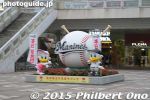
Outside JR Kaihin-Makuhari Station is a monument for the Chiba Lotte Marines pro baseball team. The stadium might be a little too far to walk if you're carrying heavy camera equipment. Take a taxi.
|
|

Chiba Marine Stadium or QVC Marine Field. Food trucks are outside on game days. Since it's next to the ocean, it can get chilly in cooler months.
|
|

Dining area for food trucks.
|
|
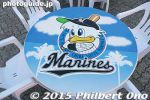
Table top
|
|
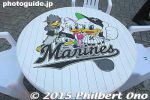
We went to see a game between Chiba Lotte Marines and Nippon Ham Fighters on Oct. 5, 2015.
|
|

Food stalls are not too popular since most fans seem to prefer to buy food inside the stadium and eat at their seats while gazing at the baseball field.
|
|
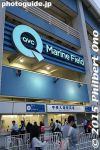
Entrance to Chiba Marine Stadium or QVC Marine Field.
|
|
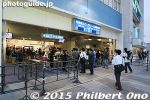
Chiba Lotte Marines is not one of the super popular baseball teams so it was easy to get tickets.
|
|
|
|
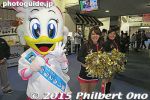
Chiba Lotte Marines cheerleaders and mascot greet you as you enter the QVC Marine Field.
|
|
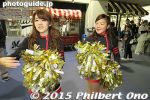
They really make you feel welcome while shaking their pom-poms.
|
|
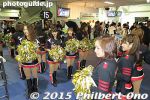
Gauntlet of Chiba Lotte Marines cheerleaders at Chiba Marine Stadium for a baseball game.
|
|
|
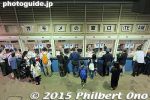
Ticket office still had tickets.
|
|
|
|

Baseball field at Chiba Marine Stadium or QVC Marine Field from first base. Holds about 30,000.
|
|

Baseball field at Chiba Marine Stadium or QVC Marine Field.
|
|
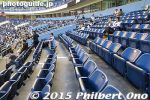
Plastic seats were comfortable enough.
|
|

Corridor
|
|
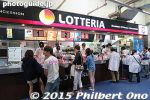
Lotteria is related to the baseball team.
|
|

The stadium has a number of fast food eateries.
|
|
|
|
|
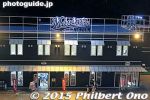
Official merchandise shop for the Marines.
|
|
|
|
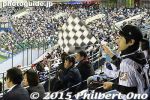
Fans cheer for the Marines playing against Nippon Ham Fighters.
|
|
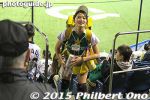
Beer girl at Chiba Marines baseball game at Chiba Marine Stadium or QVC Marine Field. One thing the U.S. major league games do not have.
|
|
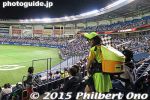
The beer girls wear a backpack of beer and dart up and down the spectator seats to sell beer that they dispense into a cup.
|
|
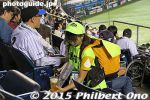
They come by very often.
|
|

Japanese beer girls at baseball games are very friendly.
|
|
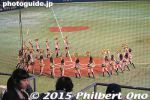
At halftime, cheerleaders perform.
|
|
|
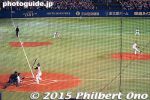
Chiba Lotte Marines vs. Nippon Ham Fighters at Chiba Marine Stadium or QVC Field.
|
|
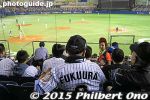
A Marines fan.
|
|
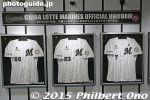
Chiba Lotte Marines official uniform.
|
|
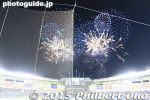
Fireworks at halftime.
|
|

Ogaki has a city-operated bicycle racetrack called the Ogaki Keirinjo or Ogaki Cycling Stadium. This is the entrance. Admission is 100 yen. 大垣競輪場
|
|

Outside the Ogaki cycling stadium which was first built in 1952. On race days, free shuttle buses run often between Ogaki Station and the stadium. It takes 10 min.
|
|

Betting ticket counters inside the cycling stadium.
|
|

There are three classes of spectator seats. At the bottom is open-air seating. Pay 500 yen for the glass-enclosed seating above, and a higher fee for suite rooms higher up.
|
|

Panoramic view of the Ogaki Cycling Stadium bicycle racetrack as seen from the free seating section.
|
|

Starting line. The entire track is ringed by a fence, making it difficult to shoot close-ups of the racers.
|
|

Starting line. On a race day, a series of races are held from morning to late afternoon.
|
|

And they're off.
|
|
|
|
|
|
|
|

In the middle is a small pond and a Japanese-style bridge.
|
|
|
|
|

On the bank.
|
|

I once rode on a similar bicycle racetrack and those banks are very steep and scary. If you fall, you will tumble downward for sure.
|
|
|
|
|
|

Two cyclists apparently collided and took a spill.
|
|
|

The fallen cyclists are taken away by stretcher. The first bicycle race I see in Japan occurs with two riders taking a fall. How dramatic.
|
|

Cyclists hauled away.
|
|
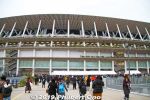
Approaching the Olympic Stadium. The white tent is where we had to show our tickets.
|
|
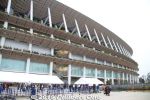
Stadium gates opened at 2 pm, stadium seating opened at 4:30 pm, and the program started at 6:30 pm. Cold, overcast day, but fortunately, it didn't rain.
|
|
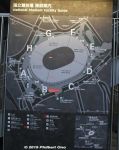
The stadium grounds has four gates (Sendagaya Gate, Gaien Gate, etc.) from the direction of train/subway stations. This map shows how far each train/subway station is.The closest is JR Sendagaya Station (440 meters) and Kokuritsu Kyogijo subway station (130 meters).
The stadium itself has eight main entrances from A to H. These main entrances further branch off into smaller entrances such as A1, A2, etc., leading to different floors and seating blocks.
The stadium seating sections are labeled Main Stand, Back Stand, North Stand, and South Stand. Each stand comprise three inclined tiers of seating. The Main Stand is the prime section. Gate F is nearest to the Japan Olympic Museum where the Olympic rings are.
|
|
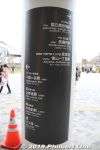
This shows how far each train/subway station is.
|
|
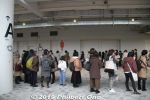
Long line for the women's restroom on the ground floor. There are men's and women's restrooms on each floor. If the line is too long, just look for another one.
|
|

It was the first time the stadium saw this many people.
|
|
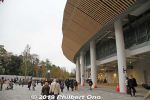
I walked completely around the stadium on the ground level outside.
|
|
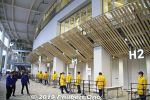
Each gate had a bag checkpoint.
|
|
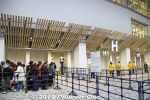
Line to enter Gate H.
|
|
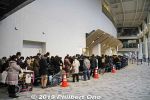
Line to enter Gate H.
|
|
|
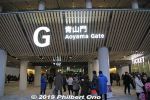
Gate G, Aoyama Gate
|
|
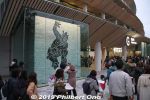
Near Gate G, a large, fresco mosaic wall mural of Nomi no Sukune, a legendary sumo wrestler posing as a victor. By pioneering artist Hasegawa Roka (長谷川路可 1897–1967). This was preserved and moved here from the old National Stadium. So this work dates from 1964. 「野見宿禰」
|
|

Mosaic wall mural of Nomi no Sukune, a legendary sumo wrestler posing as a victor. By pioneering artist Hasegawa Roka (長谷川路可 1897–1967).
|
|
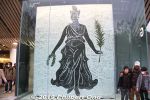
Another fresco mosaic wall mural by Hasegawa Roka. The Greek Goddess of Victory, depicting "Honor." This was preserved and moved here from the old National Stadium. 「勝利の女神」
|
|
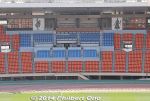
This is where Hasegawa Roka's pair of fresco wall murals were in the old National Stadium's main stand. Saw it in May 2014 when I toured the old 1964 Olympic Stadium before it was torn down to make way for the new stadium.
|
|

Looks like fire escape stairs, but they are normally used to exit the stadium. It was closed while people were entering the stadium (using escalators). The stairs were opened after the event ended.
|
|
|
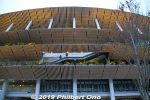
The stadium's design theme was "Forest Stadium." (杜のスタジアム). Lots of cedar lumber on the exterior. The wood came from all 47 prefectures and they point toward the place where they came from.
|
|
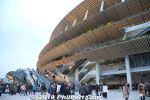
Stairs and escalator to the stadium's 2nd tier seats.
|
|
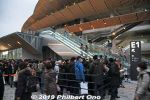
Stairs and escalator to the stadium's 2nd tier seats.
|
|
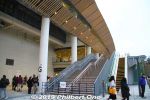
Stairs and escalator to the stadium's 2nd tier seats.
|
|
|
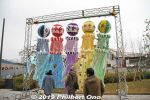
Tanabata streamers from Sendai, Miyagi Prefecture. One event highlight was Tohoku festivals.
|
|
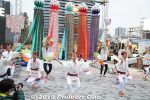
Outside Gate E, there was a short pre-event performance of the Sendai Suzume Odori dance from Sendai, Miyagi Prefecture. The Suzume Odori (Sparrow Dance) is held in late July near Sendai Station. They performed in front of Tanabata streamers for which Sendai is famous in early Aug. 仙台すずめ踊り http://www.suzume-odori.com/
|
|
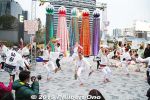
Sendai Suzume Odori dance. They were also going to be part of the main program inside the stadium. 仙台すずめ踊り http://www.suzume-odori.com/
|
|
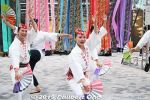
Sendai Suzume Odori dance.
|
|

Sendai Suzume Odori dance.
|
|
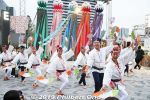
Sendai Suzume Odori dance.
|
|

Sendai Suzume Odori dance.
|
|
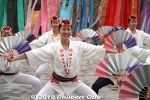
Sendai Suzume Odori dance.
|
|
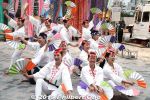
Sendai Suzume Odori dance.
|
|
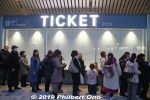
Stadium's ticket box office. It was closed since tickets to this event was sold in advance. First you had to apply for the ticket lottery online. If you won a ticket in the lottery (held at least 3 times), you could pay for it by credit card or at a convenience store. The ticket lottery and website were in Japanese only and geared for Japan residents with a cell phone. Very puzzling since it effectively shut out overseas visitors from buying a ticket. I didn't see any foreigners in the crowd. And yet, the event MC kept mentioning how it was for all nationalities, abled-bodied and disabled, all genders, all ages, etc., etc. No event info in English at all.
|
|
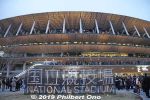
Popular photo spot with the "National Stadium" sign. Near Gaien Gate.
|
|
|
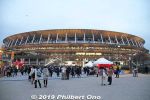
The stadium as seen from Gaien Gate. This area is where they had food stalls and corporate sponsor booths.
|
|
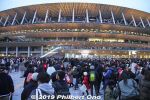
The stadium as seen from Gaien Gate.
|
|

Food stalls.
|
|
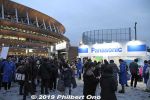
Corporate sponsor booths.
|
|
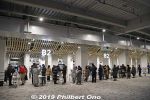
Gate B2.
|
|
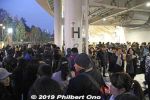
We all had reserved seating so there was no rush to get to our seats. But there was this long line for Gate A that led to seats on all three tiers (1st to 4th floors) in this section on the Main Stand. The line wound back and forth four times before we headed for Gate A.
|
|
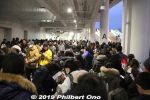
Long and winding line for Gate A.
|
|

The line moved quickly though. It took about 15 min. to get to the gate to go inside.
|
|

Entering Gate A for security check of our bags. Notice that Gate A branches off into smaller gates from A1 to A6. A1 goes to the 1st floor, A6 goes to the 4th floor.
|
|
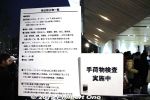
Items not allowed: Knives, scissors (longer than 5.5 cm), poison, illicit drugs, flammable things, flares, fireworks, firecrackers, explosive items, oil, hammers, screwdrivers, chains, ice picks, glass bottles, cans, canned goods, raw eggs, and more. Plastic (PET) bottle drinks are allowed, but it may be subject to inspection.
Even this sign was not in English. So I guess they weren't expecting foreigners to attend this event.
|
|

Gate A6 led to escalators going to the 4th floor. The admission ticket tells you which gate to go to.
|
|
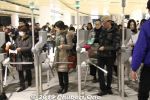
The turnstile used a QR code scanner. Show the QR code on your ticket and the turnstile unlocks for you to pass through.
|
|

The turnstile scanner machine (spare ones here).
|
|
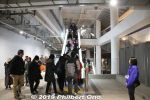
Escalator to the upper floors.
|
|

Concourse on the 4th floor. This is open-air. Quite cold this day.Concourse on the 4th floor. This is open-air. Quite cold this day. I felt sorry for the staff who were working here, standing outside the corridor entrance to the seats.
|
|
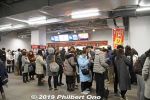
A number of concession stands along the concourse, but long lines. I brought my own food and drinks, so I didn't bother to stand in line. No vending machines in the stadium. The cheapest drinks were ¥300.
|
|
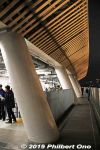
Outside the concourse.
|
|
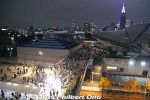
View outside the concourse, looking toward Tokyo Metropolitan Gymnasium and Sendagaya Station.
|
|
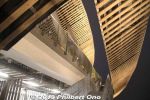
Stairs to the 5th floor where there is an open-air concourse with potted plants (Sora no Mori). But it was closed.
|
|
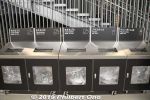
On the concourse, trash bins for burnables, plastics, and PET bottles.
|
|
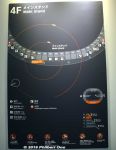
Layout of seating blocks on the Main Stand on the 4th floor (Tier 3). Notice the many concession stands and restrooms. It may be confusing to see three seating tiers, but they are on different floors. The 1st tier is on the 1st floor, the 2nd tier is on the 2nd and 3rd floors, and the 3rd tier is on the 4th and 5th floors.
|
|
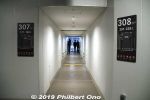
Narrow corridor to Blocks 307 and 308 on tier 3. No wheelchair seating here.
|
|

Layout of a block of seats. The block numbers indicate the tier. 100s for the 1st tier (expensive seats), 200s, for the 2nd tie, and 300s here for the 3rd tier (cheap seats, ¥5000 for this event). Here, you should check your seat No.
If your seat No. is 111 to 124, enter on the left side of the block. If it's 125 to 138, go to the other corridor entrance on the right side of the block. The field is toward the top of this diagram (Row 1).
|
|
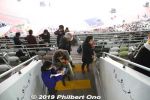
At the end of the corridor is steps going down and up. Cramped spot where people tend to stop and try to figure out which way to go. If your seat is on the other side of the block, you should go back to the concourse and enter the corridor on the other side of the block.
|
|
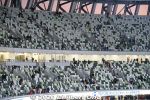
The seats have a random mosaic design in shades of green, brown, and white. It makes it look like there are spectators even when the seats are empty.
|
|
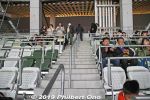
Third tier steps going up to the top row of the stadium. Above the top row is open-air. Steps are narrow and steep. Hold the hand rails.
|
|
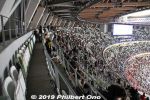
From the top row of seats in the stadium on the 3rd tier. Tier 3 has a steep 34˚ incline.The Tier 1 is more gradual at 20˚, and Tier 2 is 29˚. Lateral space was minimized, so it's quite cramped to move through the seats when people are sitting in them. And there's no walkway traversing the seating area on the cramped 3rd tier. Go back out to the concourse to move to another block.
The stadium was designed this way to keep the seats closer to the field. I must say, it is effective in that sense. The field looks closer and you get clear views with no heads in the way. In the old National Stadium, the top row was faraway from the field.
This top row is also right below the open-air part of the stadium and if it's windy and rainy, I would think people may get wet here. Must be cold in winter to sit here. But in summer, it might be cooler when there's a breeze.
|
|
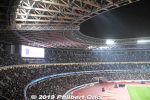
Spectator seating is pretty much covered by the roof, but windy rain can still reach people. The stadium was looking quite full.
|
|
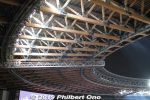
Roof laden with wood.
|
|

Awesome-looking roof. It also has loudspeakers.
|
|
|
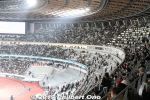
The 1st tier on the bottom has a gradual incline, the 2nd tier is steeper, and the 3rd tier is the steepest.
|
|
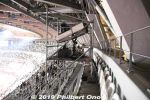
Spotlight fixture occupies three rows of 5 seats.
|
|
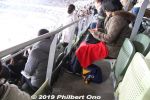
My row on the 3rd tier. Hardly any room for a person to pass in front of people sitting. Not good when someone wants to get out and I'm shooting video of a precious moment on the field.
|
|
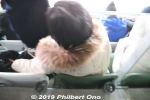
In front of me, this person's head was slightly above my knees when I was sitting. A little kid sitting can easily kick the person's head in front. The drink holder is also on the floor.
|
|
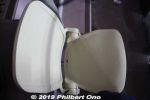
My seat, made of hard plastic.
|
|

We all got a free face towel as a souvenir.
|
|

Navigational map of the men's room. Mainly for visually impaired people, but I believe the braille is in Japanese.
|
|
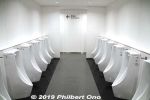
Men's room, very clean.
|
|

Semi-accessible toilet. (Too small for a wheelchair.) The wheelchair spaces had accessible toilets nearby.
|
|
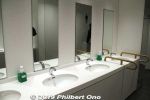
Wash basin.
|
|
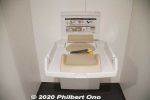
Diaper-changing table.
|
|
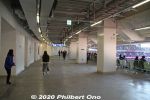
2nd tier concourse (3rd floor) does not have any crosswinds.
|
|
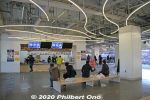
Comcession stand on 2nd tier concourse (3rd floor).
|
|
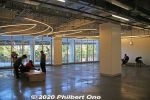
Extra space on 2nd tier concourse (3rd floor).
|
|
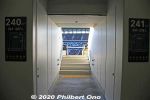
Corridor to 2nd tier seats.
|
|
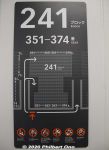
Map of a block of seats on 2nd tier. Each block has two corridors/entrances. Enter the corridor closest to your seat.
|
|
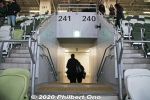
End of corridor to seats.
|
|
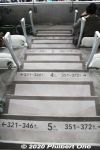
Row and seat numbers on steps on 2nd tier.
|
|
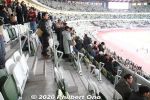
2nd tier seats, less steep than the 3rd tier.
|
|
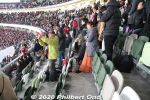
2nd tier seats.
|
|
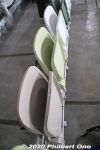
Seat numbers (without row number) are on the seat edge, not on the seat back. If there are people sitting, you cannot see the seat number.
|
|
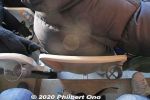
On 2nd tier, the incline is less than the 3rd tier. The drink holder is above the floor.
|
|
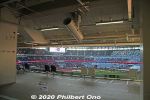
Wheelchair space on 2nd tier concourse. Seats are for abled-bodied wheelchair companions. This space also has power outlets for recharging power/electric wheelchairs. Mounted on the ceiling is a cooling fan.
|
|
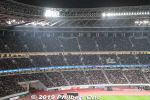
The stadium was looking quite full. The stadium capacity is 60,000, but they announced that attendance for this event was 52,000.
|
|
|
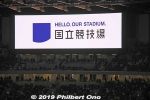
The name of the stadium's opening event was "Hello, Our Stadium." Two giant monitors were used to show live closeups of the performers.
|
|

It's an oval-shaped stadium with a track and field and partial, fixed roof. The track and field had taiko drums and kanto paper lantern poles on both ends.The seats have a random mosaic design in shades of green,
|
|
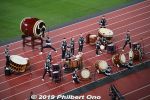
At 6:30 pm, the Opening Act was the famous taiko drum troupe Kodo from Sado, Niigata. 鼓童https://www.kodo.or.jp/en/
|
|
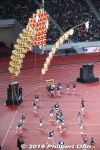
The culture part of the program featured a festival from each of the six prefectures in the Tohoku Region: Aomori, Akita, Yamagata, Miyagi, Iwate, and Fukushima Prefectures. They are all annual summer festivals. There's an emphasis on this region because it was where the March 2011 tsunami and earthquake hit Japan the hardest. The Japanese government also wants to call this the "Recovery Olympics."
|
|
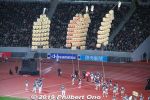
It started with the Kanto Festival from Akita Prefecture (same place where the Akita dog comes from). On both ends of the field, men in happi coats balanced tall paper lantern-bedecked bamboo poles, called kanto, on their shoulders, hand palms, or hips. These kanto symbolize rice plants. Akita Kanto Festival is held annually during Aug. 3 to 6 near JR Akita Station in Akita Prefecture. http://www.kantou.gr.jp/english/index.htm 竿灯まつり
|
|
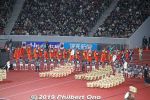
Next was the Morioka Sansa Odori dance festival from Morioka, Iwate Prefecture. It's a large-sacle evening street dance held near JR Morioka Station on Aug. 1 to 4. 盛岡さんさ踊り http://www.sansaodori.jp/foreign/english.php
|
|
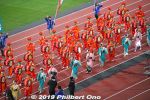
Morioka Sansa Odori Festival 盛岡さんさ踊り
|
|

Morioka Sansa Odori Festival 盛岡さんさ踊り
|
|
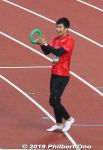
Kiryu Yoshihide, who had finished, applauds Usain Bolt and others crossing the finish. For us spectators, it was hard to see and understand what was going on
|
|

The runners celebrate on the podium.
|
|
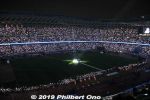
Next, the stadium went dark and the MC asked everyone to turn on their cell phone flashlight. There was one more thing... Spotlight on a surprise...
|
|
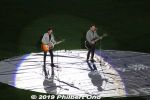
J-pop duo Yuzu appeared as an unannounced, surprise guest performer. They sang "Eiko no Kakehashi." 栄光の架橋
|
|
|
|
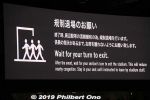
People in my block didn't heed this request. As soon as they said "This concludes today's program," we all up and left the stadium via the stairs. Got out in no time.
|
|
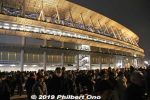
Leaving the stadium. Glad it was over. It was cold.
|
|
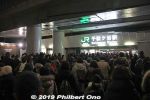
Large crowd heading to Sendagaya Station, but it went smoothly and trains came often. My next visit to the this stadium will be on New Year's Day for a national soccer/football final game.
|
|
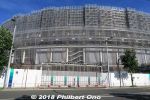
Passed by the Olympic Stadium in June 2018 when it was still under construction.
|
|
|
|
|
|
|
|

View of the Olympic Stadium in July 2018 from the Tokyo Metropolitan Government Building.
|
|

On New Year's Day 2020, Emperor's Cup JFA All-Japan Soccer Championship final game was the first sports event to be held at the new Olympic Stadium. Vissel Kobe vs. Kashima Antlers.
|
|

Outside the stadium, a large soccer ball was a popular selfie spot.
|
|

Stadium layout. Top part is the Back Stand, bottom part is the Main Stand. The Side Stands on both ends were the fan stands. The stadium has three seating tiers on five floors. Tier 3 is the cheapest seats.
|
|
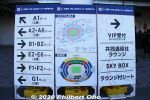
Stadium gate directions.
|
|
|
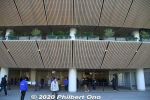
Gate A1 on the 2nd floor leading to the 2nd tier.
|
|
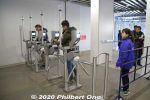
Turnstile at Gate A1. Barcode scanner lets you in.
|
|

Layout of the North Stand which was the Vissel Kobe fan section.
|
|
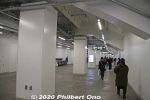
2nd tier concourse (3rd floor) does not have any crosswinds.
|
|

LCD screen showing the layout of each concourse. The wheelchair symbol is for the accessible toilets which are always near the wheelchair spaces.
|
|
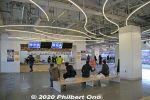
Comcession stand on 2nd tier concourse (3rd floor).
|
|
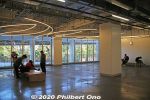
Extra space on 2nd tier concourse (3rd floor).
|
|

2nd tier concourse (3rd floor) does not have any crosswinds.
|
|
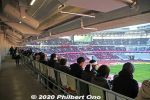
2nd tier concourse.
|
|

The seats have a random mosaic design in shades of green, brown, and white. It makes it look like there are spectators even when the seats are empty.
|
|
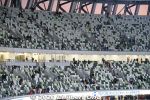
The seats have a random mosaic design in shades of green, brown, and white look like fallen autumn leaves. Ingenious. Sort of like having fake followers/spectators.
|
|
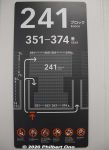
Map of a block of seats on 2nd tier. Each block has two corridors/entrances. Enter the corridor closest to your seat.
|
|
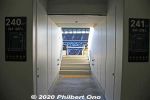
Short corridor to 2nd tier seats.
|
|
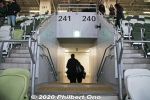
Corridor to seats in Blocks 240 and 241.
|
|
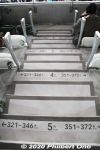
Row and seat numbers on steps on 2nd tier steps.
|
|
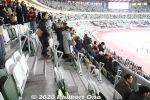
2nd tier seats, less steep than the 3rd tier.
|
|
|
|
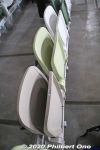
Seat numbers (without row number) are on the seat edge, not on the seat back. If there are people sitting, you cannot see the seat number.
|
|
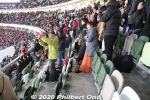
When people are sitting, there's very little room to pass through a row of seats.
|
|
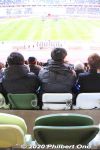
Drink holder is slightly above the floor unlike on the 3rd tier where the drink holder is on the floor.
|
|
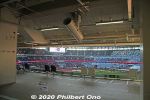
Wheelchair space on 2nd tier concourse. Seats are for abled-bodied wheelchair companions. This space also has power outlets for recharging power/electric wheelchairs. Mounted on the ceiling is a cooling fan.
|
|

Wheelchair space on 2nd tier concourse.
|
|
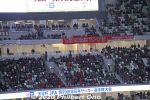
Wheelchair space on 2nd tier concourse (right below the "We came to win" banner).
|
|

It's an oval stadium with a track and field and a partial, fixed roof. Everyone was relieved that the stadium was completed in time for the Olympics after a flubbed initial design.
|
|

Seats with tables on the Main Stand.
|
|
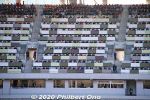
Seats with tables on the Main Stand.
|
|
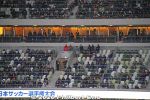
Seats with lounges.
|
|
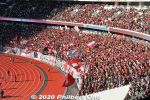
Vissel Kobe fans on the North Stand. Loud cheers. The roof overhead carried their cheers very well.
|
|
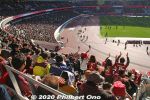
Vissel Kobe fans on the North Stand. "Vissel" combines the words "victory" and "vessel." "Vessel" because Kobe is a port city.
|
|
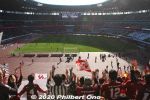
Vissel Kobe fans on the North Stand.
|
|
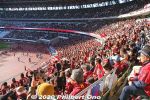
Vissel Kobe fans on the North Stand.
|
|
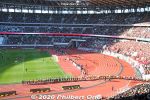
Vissel Kobe fans on the North Stand.
|
|
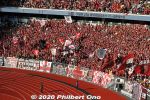
Vissel Kobe fans on the North Stand.
|
|
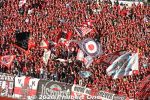
Vissel Kobe fans on the North Stand.
|
|
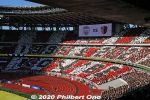
Vissel Kobe fans. "1995 to 2020, Kobe"
|
|

Kashima Antlers fans on the opposite end. Kashima, a city in Ibaraki Prefecture, literally means "deer island." That's where the "Antlers" come from.
|
|
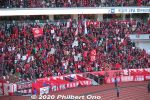
Kashima Antlers fans
|
|
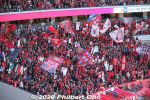
Kashima Antlers fans
|
|
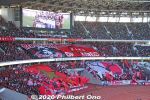
Kashima Antlers fans
|
|
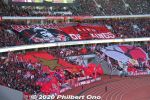
Kashima Antlers fans unfurl large banners.
|
|
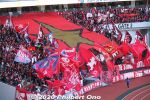
Kashima Antlers fans
|
|
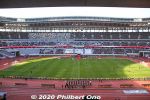
At the halfway line from the Back Stand's Tier 2 concourse with a long row of guys on the bottom edge.
|
|
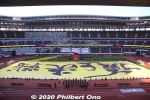
This huge banner was unfurled on the pitch. Looks upside down on my side of the stadium, but it reads "Battle for the Pinnacle." 頂上決戦
|
|
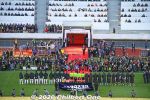
Players entered the pitch.
|
|
|
|